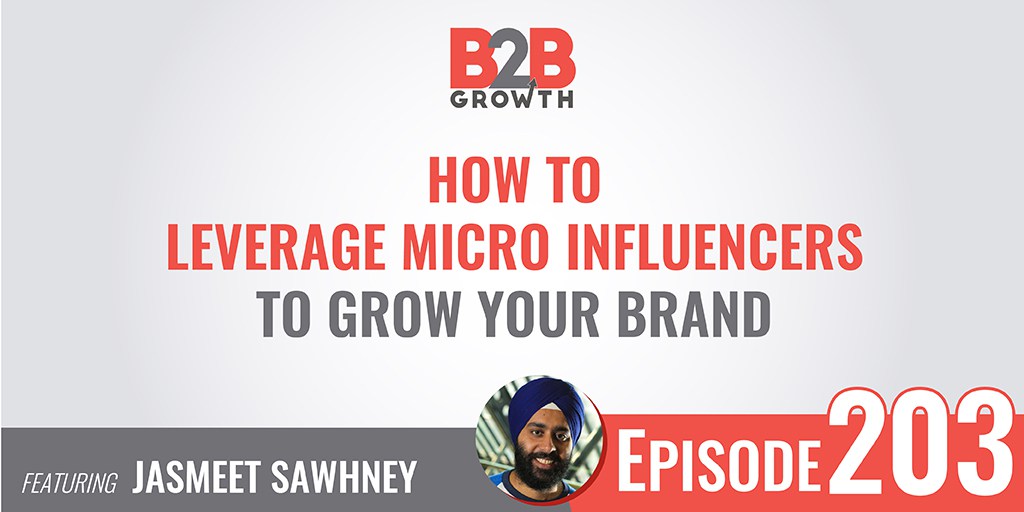Posts Tagged: digital marketing
[Podcast] How to Leverage Micro Influencers to Grow Your Brand – Published on Sweet Fish Media
Podcast interview with B2B Growth Show produced by Sweet Fish Media. It is around micro-influencers, and how B2B businesses can leverage micro-influencers as they start to build their influencer marketing programs. Also available on iTunes..
In this episode we talk to Jasmeet Sawhney, Managing Principal and CMO at YibLab.
You can find this interview, and many more, by subscribing to the B2B Growth Show on iTunes. If you don’t use iTunes, you can listen to every episode by clicking here.
via Sweet Fish Media | Podcast Production for B2B Companies.
[VIDEO] Digital Marketing: Why It As Not A Separate Marketing Function? – YouTube
In this episode, Jasmeet Sawhney talks about the ongoing debate in the marketing world. On one hand, there are folks who think that Digital Marketing is not a separate marketing function. On the other, there are folks who argue that Digital Marketing should continue to be a separate function, it should continue to be a silo within the broader marketing organization. Jasmeet provides his views on why marketing organizations should stop treating digital as a separate marketing function, why it is all just Marketing – Integrated Marketing. Watch the video for more..
via [VIDEO] Digital Marketing: Why It As Not A Separate Marketing Function? | Yiblab.
[VIDEO] Influencer Marketing & Micro-Influencers: Biggest Mistake Marketing Teams Are Making – YouTube
In this episode, Jasmeet Sawhney talks about the biggest mistake marketing teams are making in Influencer Marketing. Specifically, when marketing is trying to discover and engage with micro-influencers. Most marketing teams fail to leverage an invested group of people who are already talking about your brand, products, and services. Jasmeet also provides another tip on discovering outside influencers. Watch the video for more..
TIE Digital Marketing Keynote: Strategy to grow your business on a lean budget
Why do so many businesses struggle with digital marketing? Today’s marketing landscape allows a small company, or even an individual, to get attention of millions of digital users. How do you grow your business? Jasmeet Sawhney, CEO of YibLab and a serial entrepreneur with over 15 years of digital marketing experience will help you arrive at the answers.
Jasmeet will deconstruct two case studies, real examples of how businesses use growth hacking to engage customers and build a large customer base. You will get insights into the process, mindset, and strategies to figure out unique opportunities available to all businesses. The goal is to provide every attendee with at least a couple of actionable tactics that they can use to scale their business through an analysis of two case studies:
via Digital Marketing: Strategy to grow your business on a lean budget – TiE NJ Philadelphia.
How to Get SEO Clients? 11 Experts Chime In – Published on Agency Analytics
Believe it or not – my team has been extremely successful in signing up clients with some offline tactics. The most successful offline medium for us has been Yellow Pages. We focus on companies that run full page advertisements on YP, and then search the company on the web to make sure it has a website. Yellow Pages is a great lead qualifier because it costs thousands of dollars for a full page ad (depending on the location). If a company can spend that amount of money on a print ad, they probably have funds to improve their online presence and SEO, which in most instances has better ROI.
So, we create a list of decision makers (or marketing contacts) at these companies, and reach out to them with comparable analysis of their spend on Yellow Pages vs. website SEO, with details around what impact the same dollar amount would have if spent on SEO. Our initial plan was to use this technique for local businesses, but it worked so well that we scaled it to generate leads across US. The only catch is that most of the times you are dealing directly with business owners or traditional marketing folks who have little knowledge of digital channels. So, there is a lot of hand-holding. But, it’s all worth the effort.
via How to Get SEO Clients? 11 Experts Chime In – Agency Analytics Blog.
The Top 20 Ways To Naturally Generate Backlinks in 2016 – Published on Inet Solutions
Infographics + Memes & Visual Messages
Jasmeet Sawhney, CEO of YibLab, had two solutions to inbound links generation – one for B2B companies and one for B2C companies:
Generating inbound links requires businesses to constantly create a mix of different types of content that their audience would love to share. But, there are two specific types of content that perform the best for our B2B and B2C clients:
Infographics (for B2B companies) – The best way to generate inbound links for our B2B customers has been infographics. In a world where everyone is overwhelmed with content, getting a visual summary of a topic along with some stats is a treat. That’s exactly why infographics are so popular, and have extremely high re-publish rate. The SEO value of infographics embedded on relevant external sites is immense, which is further amplified by loads of referral traffic.
Memes and visual messages (for B2C companies) – Memes, animated gifs and text messages on a graphical background work extremely well for companies trying to engage their customer audience. These are simple and cheap to create and get shared a lot. Of course, the graphics and messaging have to be relevant to the product or service the business is selling. Memes and visual messages that mix in humor perform even better and get reposted a lot.
via The Top 20 Ways To Naturally Generate Backlinks in 2016 | Inet Solutions.
How to get better ROI out of your social media sharing? – Published on LinkedIn
We all share content on one or more social networks. In fact, social sharing has become one of the most common activities on the web. There are some who get a kick out of sharing everything in their life (“I just took a shower with chilling cold water!”); some feel connected when they share; some want to stay relevant within their circles; some want to build their credibility; and there are others who do it for various vague and valid reasons. But, very few understand how effective their sharing is, and how can they improve.
sharing comes with an expectation – that your connections and followers will react. If there are no reactions, incentives of sharing are diminished, which leads to decreased sharing.
No matter what you do for living, I can bet you have limited time. When you are active on social networks, it can take away good chunk of your time depending on how addicted (or dedicated) you are to building your presence. But, it is not hard to see that everyone’s social content does not get equal engagement. And, that is fine for most people. If all you want is to share your personal pictures with friends and family, you don’t really need to count likes and comments. But, even then, sharing comes with an expectation – that your connections and followers will react. If there are no reactions, incentives of sharing are diminished, which leads to decreased sharing.
via How to get better ROI out of your social media sharing? | Jasmeet Sawhney | LinkedIn.
Traditional Pharma Sales Model – Is It Really Broken? – LinkedIn Group
There is a lot of hue and cry about traditional Pharma sales model and why it doesn’t work – prescriber access, ROI concerns, more stakeholders in the process, regulations, and so on..But, are these real issues? Most Pharma companies continue to spend Billions on the traditional model – why? Is it really not working?
According to you, what are the things that work? And, what are some of the most prominent issues in the traditional sales process?
via FiercePharma A Network of Pharmaceutical Professionals - Traditional Pharma sales model – is it really broken? | LinkedIn.
via Pharmaceutical Sales Representative - Traditional Pharma sales model – is it really broken? | LinkedIn.
via PMSA - Traditional Pharma sales model – is it really broken? | LinkedIn.
What Retailers Need To Do In Light Of Recent Google Changes? Build Content Sites! – Retail Spokes Blog
Google recently updated its search algorithm, which according to Google will affect about 11.8% of searches. The change is targeted towards pushing down sites with low-quality content. According to a blog post by Amit Singhal, Google Fellow, and Matt Cutts, Principal Engineer:
“This update is designed to reduce rankings for low-quality sites—sites which are low-value add for users, copy content from other websites or sites that are just not very useful. At the same time, it will provide better rankings for high-quality sites—sites with original content and information such as research, in-depth reports, thoughtful analysis and so on.”
So, what do retail sites do in light of these changes? The answer is simple – create high-quality original content that attracts backlinks naturally. The blog post by Amit and Matt further states importance of high quality content:
“Google depends on the high-quality content created by wonderful websites around the world, and we do have a responsibility to encourage a healthy web ecosystem. Therefore, it is important for high-quality sites to be rewarded, and that’s exactly what this change does.”
Archives
- May 2017
- April 2017
- March 2017
- February 2017
- November 2016
- October 2016
- September 2016
- August 2016
- July 2016
- April 2016
- March 2016
- February 2016
- January 2016
- November 2015
- October 2015
- July 2015
- June 2015
- May 2015
- April 2015
- December 2014
- June 2014
- May 2014
- April 2014
- December 2013
- October 2013
- September 2013
- August 2013
- July 2013
- November 2012
- October 2012
- September 2012
- August 2012
- July 2012
- June 2012
- May 2012
- April 2012
- March 2012
- February 2012
- January 2012
- December 2011
- November 2011
- March 2011
- January 2011







Does Your Rigor Match Your Risk? – Disqus Comment On PharmExec
Your brand Is liable
Cases like these are not atypical in today’s world. Pharmaceutical executives need to think about evolving technology and be prepared for the impact when glitches happen. After all, the possibility exists that glitches may represent the same level of liability as a brand recall.
If your digital property is riddled with errors, your target is going to have a suboptimal experience. In other words, defects erode the relationship your target has with your brand.
via Does Your Rigor Match Your Risk? – Pharmaceutical Executive.